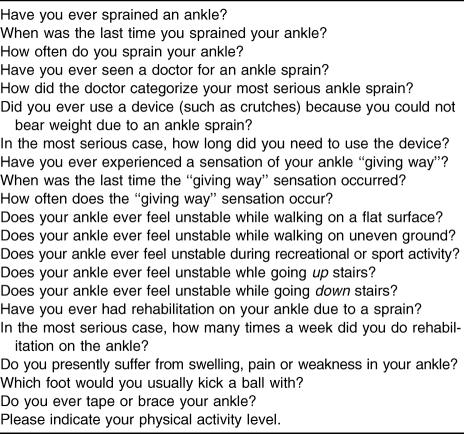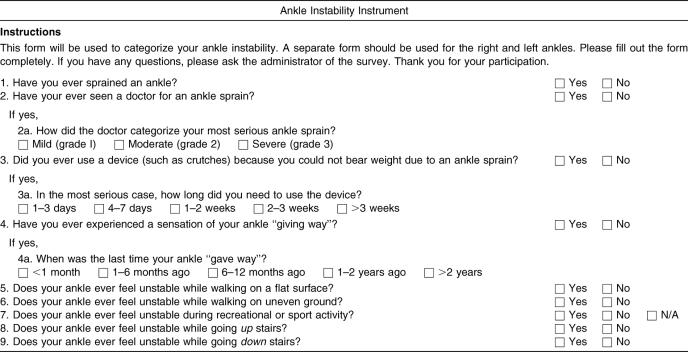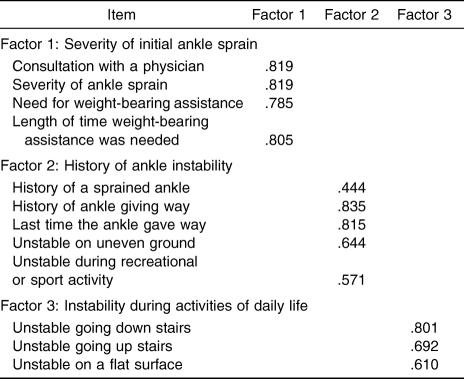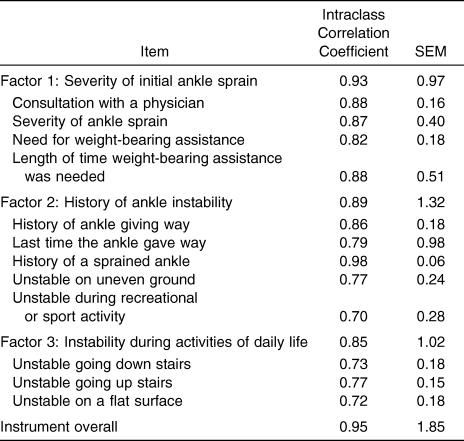Abstract
Context: Functional ankle instability has been defined in a variety of ways. Factors that are frequently used in this definition include a history of a severe ankle sprain, a history of multiple ankle sprains, and a recurrent feeling of instability or “giving way.” With all the variations in defining functional ankle instability, it becomes increasingly important to develop a more consistent framework for assessing this instability.
Objective: To develop a new ankle instability assessment tool, the Ankle Instability Instrument, and evaluate the reliability of this instrument.
Design: Test-retest reliability was evaluated using intraclass correlation coefficients (2,1) for each item, each factor, and the total score between test days 1 and 2. Cronbach alpha was calculated to estimate internal consistency of the 12 items.
Setting: Classrooms, offices, athletic fields, and private residences.
Patients or Other Participants: College students (29 males, 72 females, age = 20.7 ± 2.7 years), including 73 (72%) with and 28 (28%) without a history of ankle injury.
Main Outcome Measure(s): Subjects were asked to complete the Ankle Instability Instrument on 2 occasions approximately 1 week apart.
Results: An exploratory factor analysis of the Instrument produced 3 factors and reduced it from 21 to 12 items. The factors accounted for 32.3%, 10.7%, and 7.0% of the variance, respectively. Together, these factors accounted for 50.0% of the variance in the responses to the Instrument. Test-retest reliability ranged from .70 (SEM = 0.28) to .98 (SEM = 0.06) for the individual items and .95 (SEM = 1.85) for the Instrument overall. The Cronbach alpha coefficient was .92 for factor 1 (severity of initial ankle sprain), .87 for factor 2 (history of ankle instability), .81 for factor 3 (instability during activities of daily life), and .89 for the Instrument overall.
Conclusions: The creation of the Ankle Instability Instrument is a first step in recognizing a more objective way of identifying patients suffering from functional ankle instability. The high reliability we found shows that self-reporting of ankle symptoms is a feasible, appropriate way to obtain information on the presence of instability symptoms. Additionally, through this preliminary study, we found 3 factors that represent unique and important components of functional ankle instability. Clinicians and researchers can, therefore, use these 12 items, either alone or in combination with other information, to determine if functional ankle instability is present.
Keywords: ankle assessment, ankle sprain, functional ankle instability
Functional ankle instability (FAI) was initially defined in 1965 by Freeman 1 as a tendency for the foot to “give way.” Although this definition primarily reflects a single-dimension subjective symptom, it remains the primary criterion used today. Without the presence of an objective test (or “gold standard”), it is difficult for clinicians to appropriately assess FAI.
In the last 15 years, the most common inclusion criterion for FAI has been a history of multiple ankle sprains with a recurrent feeling of giving way. 2–6 This very liberal definition allows the clinician or researcher to state the number of giving-way episodes necessary to constitute the presence of FAI. However, little research has been done to accurately assess exactly how often this sensation must occur to be deemed FAI. Consequently, these studies could result in the inclusion of subjects who may or may not have FAI.
Other authors 7–10 have placed a greater emphasis on the severity of the initial ankle sprain in addition to the repeated sensation of giving way. In these studies, at least 1 sprain had to be severe enough that a physician was consulted and/or crutches were needed to assist in walking. The premise of this defining factor establishes that at least 1 ankle sprain was severe enough to significantly damage the structures in the ankle.
How recently or how frequently the ankle sprain occurred or recurred has also been used as inclusion criteria in some studies. 8 9 11 12 In these studies, most of the patients required a specific number of sprains in the last 12 months to be included. This more stringent criterion emphasizes a current and ongoing presence of ankle sprains; however, whether injury recency actually correlates with FAI has not been well documented. Conversely, Itay and Ganel 13 concluded that a 1-time ankle sprain could establish FAI, and subsequent sprains were not necessary. Thus, a single severe sprain that occurred years ago could continue to cause episodes of functional instability today.
Several investigators have required subjects to be free from any acute symptoms 5 6 9 14 and/or to have had no injury in the last 3 to 6 months to be included. 4 5 14–18 These criteria have been used to prevent confounding results that may occur due to acute lateral ankle sprain symptoms not associated with the chronic disability. In addition, investigators have eliminated subjects who were involved in rehabilitation at the time of the study. 2 5 9 16 17 Although such an exclusion may assist in decreasing confounding variables, it might also be helpful to document any history of rehabilitation. Other FAI inclusion criteria include normal ankle range of motion, 5 6 14 no mechanical instability, 9 and no history of lower leg fractures. 4 9 16 17 19
With all the variation in defining FAI, developing a more complex framework for assessing FAI becomes increasingly important. We believe that this framework should include severity and frequency of the instability, as well as a determination of the activities that may predispose the ankle to give way. This paper reports our attempt to use those factors as components of a new ankle instability assessment tool.
Assessment or screening instruments can assist with identification of joint injury and have been developed for several joints in the body to determine the presence of instability or injury. 20 21 Mechanical instability, or movement beyond the normal physiologic range of motion, can be objectively assessed with joint laxity tests, such as the anterior drawer test or talar tilt test, or with stress radiographs. To date, however, no such test or instrument exists for assessing FAI. Screening tools have been developed to assess pain and disability associated with ankle joint disease 22 23 and either acute lateral ankle sprains 24 or postoperative ankle sprains, 25 but no instrument has been specifically developed to assist in assessing FAI.
Because of the variation in defining FAI and the subsequently conflicting results from research focusing on FAI, it seems relevant to develop an objective means of assessing this condition. Consequently, the purpose of our study was two-fold: (1) to develop the Ankle Instability Instrument (AII), and (2) to evaluate the reliability of the AII.
METHODS
Subjects
A total of 101 healthy college students (29 males, 72 females, age = 20.7 ± 2.7 years) from a large university volunteered for this study. Subjects were recruited from kinesiology classes, activity classes, and intramural sports teams. No recruitment incentives were offered for this study. Subjects included 73 participants (72%) with and 28 (28%) without a history of ankle injury. Of the injured participants, 22 (30%) had sprained the right ankle, 13 (18%) had sprained the left ankle, and 38 (52%) had sprained both ankles. All participants were physically active, with 87 subjects (86%) participating in competitive or recreational sports and 14 subjects (14%) participating in biking, jogging, or swimming activities. For all data analysis, the injured limb was tested in the injured participants, and a randomly chosen limb was tested in the uninjured participants. For the 38 participants with a history of injury in both limbs, both ankles were included. This provided a total of 139 ankles for the statistical analysis. The Institution's Human Investigation Committee approved the study, and all subjects read and signed a written consent form before testing.
Procedures
Subjects were asked to complete the AII on 2 separate occasions approximately 1 week apart. Data collection was done in classrooms, offices, athletic fields, and, in a few occasions, private residences. The primary investigator was present during all testing sessions and assured that no outside distractions occurred during the testing period. Subjects were allowed as much time as necessary to complete the survey but normally completed it within 10 minutes.
Instrument Development
Reviewing the foot and ankle literature provided us with appropriate information to develop the preliminary instrument. Subsequently an investigation of content validity was done in consultation with 2 physicians (general medicine and orthopaedic surgeon) and several other health care providers (physical therapists and certified athletic trainers). From these 2 methods, we formed an initial instrument of 21 questions about ankle instability ( Table 1). The focus of the 21 questions was the history, presence, and severity of ankle instability, as well as functional performance. To reduce the data into meaningful units, we performed an exploratory factor analysis.
Table 1. Initial 21 Items Used in the Development of the Ankle Instability Instrument.
The exploratory factor analysis was conducted on all 21 items. Principal axis factoring was the extraction method and varimax was the rotation method. Our expectation was that, when combined, the identified factors could represent the overall presence of FAI, and individually, they would represent subcomponents of the instability. Factors were included if they had an eigenvalue greater than 1.0 and explained greater than 5% of the variance.
The 3 retained factors consisted of 12 items ( Table 2). Factor 1 (severity of initial ankle sprain) included 4 items (2, 2a, 3, and 3a) and accounted for 32.3% of the variance. Factor 2 (history of ankle instability) included 5 items (1, 4, 4a, 6, and 7) and accounted for an additional 10.7% of the variance. Factor 3 (instability during activities of daily life) included 3 items (5, 8, and 9) and accounted for an additional 7.0% of the variance. Overall, these 3 factors accounted for 50.0% of the variance in the responses to the AII. Items and the factor loading are shown in Table 3. For this analysis, the suppression threshold was set at .40. At this threshold, each item only loaded into 1 factor.
Table 2. Retained Items Used to Assess Functional Ankle Instability.
Table 3. Factor Analysis Rotated Component Matrix.
Clinically, these factors include the information patients have been reporting and anecdotally what clinicians have viewed as signs and symptoms that are present in someone with FAI. Factor 1 includes information about the severity of the initial ankle sprain. Theoretically, a more severe ankle sprain has the potential to cause greater damage to the structures around the ankle and potentially lead to more residual symptoms. The need to consult with a physician or an injury severe enough to require crutches or other weight-bearing assistance is an objective measure. Factor 1 was therefore labeled “severity of initial ankle sprain.” Factor 2 includes traditional inquiries about the presence of the initial ankle sprain, repeated episodes of giving way, and instability during challenging activities (ie, walking on uneven ground, during sport activity). Therefore, we labeled factor 2 “history of ankle instability.” Factor 3 included items regarding the effect of ankle instability during normal activities that occur on a daily basis. Factor 3 was labeled “instability during activities of daily life.” Each factor represents components of FAI and, potentially, these factors could serve as an objective means to identify those with FAI.
Statistical Analysis
Test-retest reliability was evaluated using intraclass correlation coefficients (2,1) for each item, each factor, and the total score on the AII between test days 1 and 2. The Cronbach alpha was calculated to estimate internal consistency of the 12 items.
RESULTS
Subjects completed the AII an average of 7 days apart (range, 4–19 days). Of all 139 ankles, 111 (80%) had a history of ankle injury and 28 (20%) did not. Of the injured participants, 49 (44%) of the ankles had been evaluated by a physician (14 were mild sprains, 20 were moderate sprains, and 15 were severe sprains). Seventy-six (69%) of the injured ankles had experienced a sensation of giving way. Of those, 33 (43%) had giving way in the last month, 20 (26%) had giving way 1 to 6 months ago, 8 (11%) had giving way 6 to 12 months ago, 11 (15%) had giving way 1 to 2 years ago, and 4 (5%) had experienced the giving way more than 2 years ago. Self-reported instability was also recorded during a variety of activities. Of the injured ankles, 18 ankles felt unstable while walking on a flat surface, 58 ankles felt unstable while walking on uneven ground, 61 ankles felt unstable during recreational or sport activity, 12 ankles felt unstable going up stairs, and 18 ankles felt unstable going down stairs.
As reported in Table 4, test-retest reliability intraclass correlation coefficients (2,1) ranged from a low of .70 (SEM = .275) to a high of .98 (SEM = .061) for the items on the AII. Reliability of the individual factors and the overall instrument was .93 (SEM = .972) for factor 1, .89 (SEM = 1.324) for factor 2, .85 (SEM = 1.024) for factor 3, and .95 (SEM = 1.853) for the overall instrument. The Cronbach alpha coefficients were .92, .87, and .81 for factors 1, 2, and 3, respectively, and .89 for the overall instrument.
Table 4. Intraclass Correlation Coefficients of the Ankle Instability Instrument.
DISCUSSION
Because FAI is primarily determined by self-reported characteristics, it is important that people are able to consistently remember and report these symptoms. We found that subjects could report their symptoms on successive occasions with high reliability. This recall included the reporting of each of the aspects of their ankle characteristics, from physician consultation to instability going up and down stairs. We felt it was important to test the reliability of each individual question as well of that of each factor and the overall instrument. This testing allowed us to identify any questions that might have been difficult for the participants to recall and, therefore, would decrease the reliability of the overall instrument. Intraclass correlation coefficient values were high for all questions, so this was not a concern.
Internal consistency was evaluated with the Cronbach alpha, which is an index of reliability. For the purpose of this study, we wanted to evaluate the internal consistency of the AII (12 items) and the 3 individual factors identified through the factor analysis. In factor 1 (severity of initial ankle sprain), we found that consultation with a physician, grade of ankle sprain provided by that physician, inability to bear weight, and the length of time weight-bearing assistance was needed are relatively homogeneous and give a good representation of the severity of previous ankle sprains. Although consultation with a physician and the need for weight-bearing assistance have been previously documented inclusion criteria, 2 14 16 the additional information about the severity of the ankle sprain and the length of time crutches were needed 5 7–10 26 may provide a better assessment of the severity of previous ankle sprains.
Factor 2 (history of ankle instability) included items regarding the history of an ankle sprain, history of the ankle giving way, last time the giving-way episode occurred, instability when walking on uneven ground, and instability during recreational or sport activity. These items combine to reflect the general presence of ankle instability. Some of these items have been used in previous FAI inclusion criteria 2–6; however, the presence of instability during specific activities, such as walking on uneven ground or during sport activity, has never been addressed. Because FAI implies disability during activity, this is an important component in addressing the presence of FAI.
Factor 3 (instability during activities of daily life) combined instability on a flat surface and instability while ascending and descending stairs. These items reflect instability during activities of daily life. The presence of instability during relatively normal activities could represent a significant instability that affects individuals on a frequent basis. Additionally, these items could represent the presence of an ongoing or persistent instability. The alpha coefficients for each of these factors as well as for the overall AII are well above what is conventionally acceptable. 27
Several subjects had bilateral ankle instability. For statistical analysis, as previously mentioned, those with bilateral ankle instability were included as 2 ankles. Of the injured subjects, those with unilateral (48%) and those with bilateral (52%) injuries were relatively equally distributed. Obviously some of the questions related to walking, ascending and descending stairs, and sport activity are bilateral in nature, but subjects were instructed to complete the AII for symptoms of only 1 ankle at a time. Future research is necessary to determine if instability of 1 ankle may predispose the contralateral ankle to this instability as well.
A limitation of this study was the number of subjects. Although a sample of 101 subjects is large for traditional sports medicine research, when performing this type of analysis, sample sizes are typically larger. However, this n did meet the minimum standard of subject-to-variable ratio of 5 (101 subjects/21 items = 4.81). 28 This study was exploratory in nature and serves as the initial step to developing a better way to identify subjects with FAI.
Additionally, we did not have equal numbers of men and women in this study. With the current inclusion criteria, approximately twice as many women volunteered as men. Therefore, we were unable to specifically look at sex in our analysis. Previous researchers have not specifically established sex differences at the ankle, but such differences may play a role in the presence of FAI. Additional study is needed in this area.
CONCLUSIONS
The creation of the AII is a first step in recognizing a more objective way to identify participants suffering from FAI. The high reliability found when using this instrument shows that self-reporting of ankle symptoms is a feasible and appropriate way to obtain information on instability symptoms.
The AII could provide the clinician and researcher with a more meaningful starting point when examining subjects with FAI. This investigation identifies certain questions that provide information about participants with FAI. By gathering data on these 12 items, we can determine the range of severity of FAI. Researchers can specifically decide how liberal or conservative they would like to be in identifying those with FAI. For example, some may choose to include only factor 3, instability during activities of daily life, whereas others may be more conservative and require affirmative responses to all the items before classifying someone as having FAI. Because all questions are not dichotomous in nature, the answers to the AII cannot simply be added to create an FAI score. Instead, clinicians must look at their populations and see which items would best reflect the level of instability concerning them the most. Continued research is needed to recreate this study with a larger sample size to see if these results can be repeated.
REFERENCES
- Freeman MAR. Instability of the foot after injuries to the lateral ligament of the ankle. J Bone Joint Surg Br. 1965;47:669–677. [PubMed] [Google Scholar]
- Tropp H. Pronator muscle weakness in functional instability of the ankle joint. Int J Sports Med. 1986;7:291–294. doi: 10.1055/s-2008-1025777. [DOI] [PubMed] [Google Scholar]
- Gauffin H, Tropp H, Odenrick P. Effect of ankle disk training on postural control in patients with functional instability of the ankle joint. Int J Sports Med. 1988;9:141–144. doi: 10.1055/s-2007-1024996. [DOI] [PubMed] [Google Scholar]
- Wilkerson GB, Pinerola JJ, Caturano RW. Invertor vs. evertor peak torque and power deficiencies associated with lateral ankle ligament injury. J Orthop Sports Phys Ther. 1997;26:78–86. doi: 10.2519/jospt.1997.26.2.78. [DOI] [PubMed] [Google Scholar]
- Hartsell HD, Spaulding SJ. Eccentric/concentric ratios at selected velocities for the invertor and evertor muscles of the chronically unstable ankle. Br J Sports Med. 1999;33:255–258. doi: 10.1136/bjsm.33.4.255. [DOI] [PMC free article] [PubMed] [Google Scholar]
- Rozzi SL, Lephart SM, Sterner R, Kuligowski L. Balance training for persons with functionally unstable ankles. J Orthop Sports Phys Ther. 1999;29:478–486. doi: 10.2519/jospt.1999.29.8.478. [DOI] [PubMed] [Google Scholar]
- Bernier JN, Perrin DH, Rijke AM. Effect of unilateral functional instability of the ankle on postural sway and inversion and eversion strength. J Athl Train. 1997;32:226–232. [PMC free article] [PubMed] [Google Scholar]
- Bernier JN, Perrin DH. Effect of coordination training on proprioception of the functionally unstable ankle. J Orthop Sports Phys Ther. 1998;27:264–275. doi: 10.2519/jospt.1998.27.4.264. [DOI] [PubMed] [Google Scholar]
- Kaminski TW, Perrin DH, Gansender BM. Eversion strength analysis of uninjured and functionally unstable ankles. J Athl Train. 1999;34:239–245. [PMC free article] [PubMed] [Google Scholar]
- Hess DA, Joyce CJ, Arnold BL, Gansneder BM. Effect of 4-week agility-training program on postural sway in the functionally unstable ankle. J Sport Rehabil. 2001;10:24–35. [Google Scholar]
- Ryan L. Mechanical stability, muscle strength and proprioception in the functionally unstable ankle. Aust J Physiother. 1994;40:41–47. doi: 10.1016/S0004-9514(14)60453-0. [DOI] [PubMed] [Google Scholar]
- Konradsen L, Magnusson P. Increased inversion angle replication error in functional ankle instability. Knee Surg Sports Traumatol Arthrosc. 2000;8:246–251. doi: 10.1007/s001670000124. [DOI] [PubMed] [Google Scholar]
- Itay S, Ganel A. Clinical and functional status following lateral ankle sprains: followup of 90 young adults treated conservatively. Orthop Rev. 1982;11:73–76. [Google Scholar]
- Hartsell HD. The effects of external bracing on joint position sense awareness for the chronically unstable ankle. J Sport Rehabil. 2000;9:279–289. [Google Scholar]
- Garn SN, Newton RA. Kinesthetic awareness in subjects with multiple ankle sprains. Phys Ther. 1988;68:1667–1671. doi: 10.1093/ptj/68.11.1667. [DOI] [PubMed] [Google Scholar]
- Lentell G, Baas B, Lopez D, McGuire L, Sarrels M, Snyder P. The contributions of proprioceptive deficits, muscle function, and anatomic laxity to functional instability of the ankle. J Orthop Sports Phys Ther. 1995;21:206–215. doi: 10.2519/jospt.1995.21.4.206. [DOI] [PubMed] [Google Scholar]
- Lentell G, Katzman LL, Walters MR. The relationship between muscle function and ankle stability. J Orthop Sports Phys Ther. 1990;11:605–611. doi: 10.2519/jospt.1990.11.12.605. [DOI] [PubMed] [Google Scholar]
- Jerosch J, Bischof M. Proprioceptive capabilities of the ankle in stable and unstable joints. Sports Exerc Inj. 1996;2:167–71. [Google Scholar]
- Vaes PH, Duquet W, Casteleyn PP, Handelberg F, Opdecam P. Static and dynamic roentgenographic analysis of ankle stability in braced and nonbraced stable and functionally unstable ankles. Am J Sports Med. 1998;26:692–702. doi: 10.1177/03635465980260051601. [DOI] [PubMed] [Google Scholar]
- Bellamy N, Buchanan WW, Goldsmith CH, Cambell J, Stitt LW. Validation study of WOMAC: A health status instrument for measuring clinically important patient relevant outcomes to anti-rheumatic drug therapy in patients with osteoarthritis of the hip or knee. J Rheumatol. 1988;15:1833–1840. [PubMed] [Google Scholar]
- Finch E, Walsh M, Thomas SG, Woodhouse LJ. Functional ability perceived by individuals following total knee arthroplasty compared to age-matched individuals without knee disability. J Orthop Sports Phys Ther. 1998;27:255–263. doi: 10.2519/jospt.1998.27.4.255. [DOI] [PubMed] [Google Scholar]
- Budiman-Mak E, Conrad KJ, Roach KE. The Foot Function Index: a measure of foot pain and disability. J Clin Epidemiol. 1991;44:561–570. doi: 10.1016/0895-4356(91)90220-4. [DOI] [PubMed] [Google Scholar]
- Olerud C, Molander H. A scoring scale for symptoms evaluation after ankle fracture. Arch Orthop Trauma Surg. 1984;103:190–194. doi: 10.1007/BF00435553. [DOI] [PubMed] [Google Scholar]
- Williams GN, Molloy JM, DeBeradino TM, Arciero RA, Taylor DC. Evaluation of the Sports Ankle Rating System in young, athletic individuals with acute lateral ankle sprains. Foot Ankle Int. 2003;24:274–282. doi: 10.1177/107110070302400314. [DOI] [PubMed] [Google Scholar]
- Kaikkonen A, Kannus P, Jarvinen M. A performance test protocol and scoring scale for the evaluation of ankle injuries. Am J Sports Med. 1994;22:462–469. doi: 10.1177/036354659402200405. [DOI] [PubMed] [Google Scholar]
- Birmingham TB, Chesworth BM, Hartssell HD, Stevenson AL, Lapenskie GL, Vandervoort AA. Peak passive resistive torque at maximum inversion range of motion in subjects with recurrent ankle inversion sprains. J Orthop Sports Phys Ther. 1997;25:342–348. doi: 10.2519/jospt.1997.25.5.342. [DOI] [PubMed] [Google Scholar]
- DeVellis RF. Scale Development: Theory and Applications. Newbury Park, CA: Sage; 1991.
- Bryant FB, Yarnold PR. Principal-components analysis and exploratory and confirmatory factor analysis. In: Grimm LG, Yarnold PR, eds. Reading and Understanding Multivariate Analysis.Washington, DC: American Psychological Association; 1995:99–136 .






